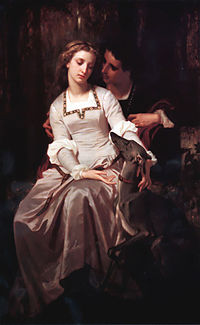Tristram and Iseult
Tristram and Iseult, published in 1852 by Matthew Arnold, is a narrative poem containing strong romantic and tragic themes. This poem draws upon the Tristan and Iseult legends which were popular with contemporary readers.[1]

Overview
The poem opens with Tristram upon his deathbed. The monologue of the dying man is shot through by sharp pangs of regret: centering upon his induced passion for Iseult of Ireland – inflamed by his unwittingly imbibing an irresistible love-potion.
Before his decease Iseult of Ireland arrives in time to share his deathbed. Iseult of Brittany, his lawful wife, graciously accedes to their request to be buried near each other – in a splendidly-constructed mausoleum back in King Mark's Tyntagel (sic.) in Cornwall.
Iseult of Brittany survives to raise Tristram's children in isolation. She forgives Tristram his adultery, and with delightful pathos is thankful for the years of happiness that she spent espoused to one of King Arthur's most renowned knights.[2]
See also
Tristan and Iseult — romantic narrative from medieval and modern Western literature
Notes
- Arnold, Matthew. Poetic Works. London: Oxford University Press, 1950.
- Arnold, Matthew. Poetic Works. London: Oxford University Press, 1950. pp. 130-ff.
External links
- Tristram and Iseult (Librivox audiobook recording)
- Tristram and Iseult (from Archive.org)
